Introduction
The importance of histopathology can hardly be overrated. Defined as the analysis of a tissue sample carried out with the help of a microscope to locate possible health issues (Bennett 2012), the field in question helps locate the factors that may possibly enhance the growth of malignant lumps and, therefore, ensure that the patient should not be exposed to the harmful environment.
Aims
The key goal of this practical is to learn to identify changes in the patient’s body, which may lead to the development of malignant lumps, as well as prevent or address the specified changes correspondingly. The practical has helped me locate the key symptoms of carcinoma development in a patient, as well as assure that the target audience should be protected from the factors that may possibly contribute to the development of the specified disease.
Additionally, the practical assignment mentioned above has created premises for learning more about the issue of breast cancer. There is no need to stress that this disease remains one of the key threats to women’s health worldwide; thus, addressing it properly is the prime responsibility of a therapist.
Methods
The practice in question was carried out with the help of specific equipment; particularly, a microscope was used to identify the alterations in the sample tissue.
Results and Discussion
Normal Skin Histology
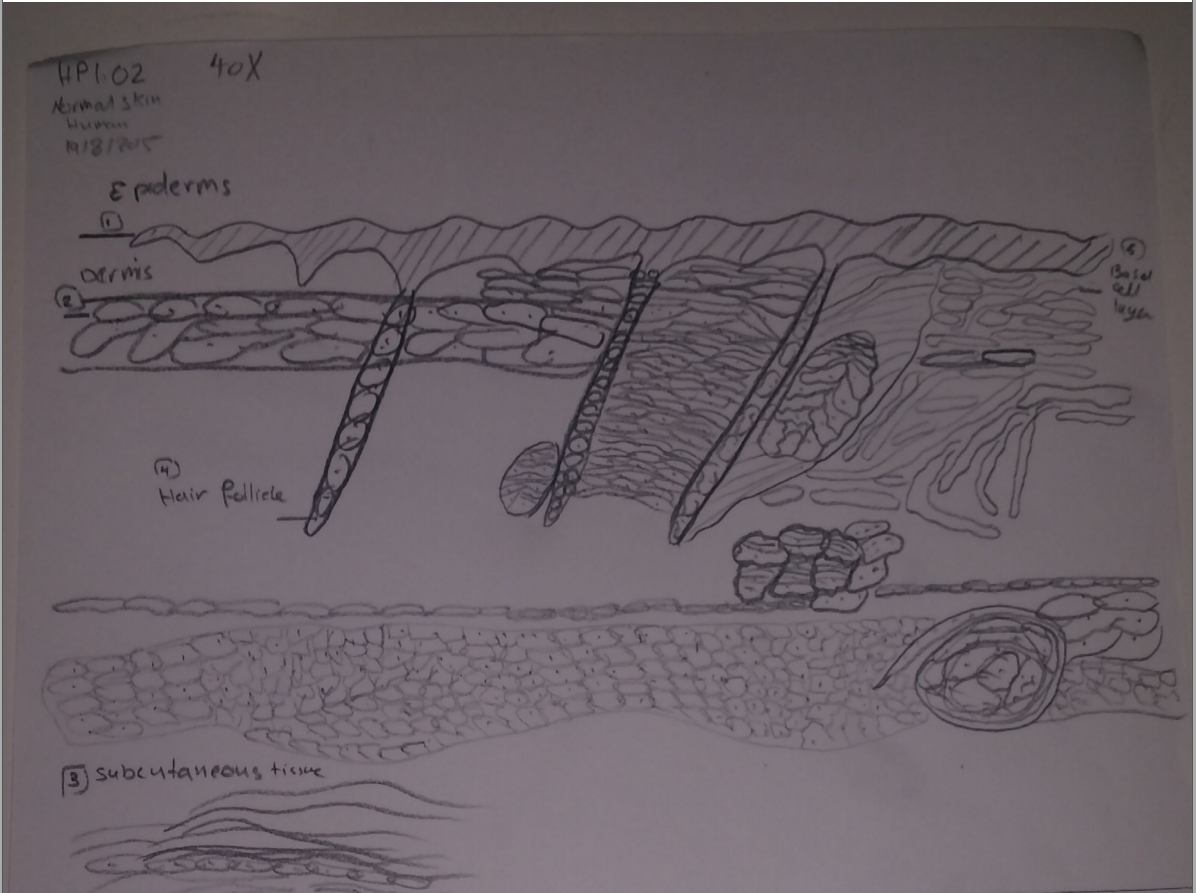
Three key layers of skin are identified. These are epidermis, dermis and hypodermis. Epidermis, or the outer layer, is characterised by ridges and squamous epithelium. Dermis, or the middle layer, is split into a papillary and a reticular level. The former consists of blood vessels, nerves, lymph, etc. The latter, in its turn, includes vascular plexus, lymph, nerves, collagen fibres, etc. (Yong, Woodford & O’Dowd 2013).
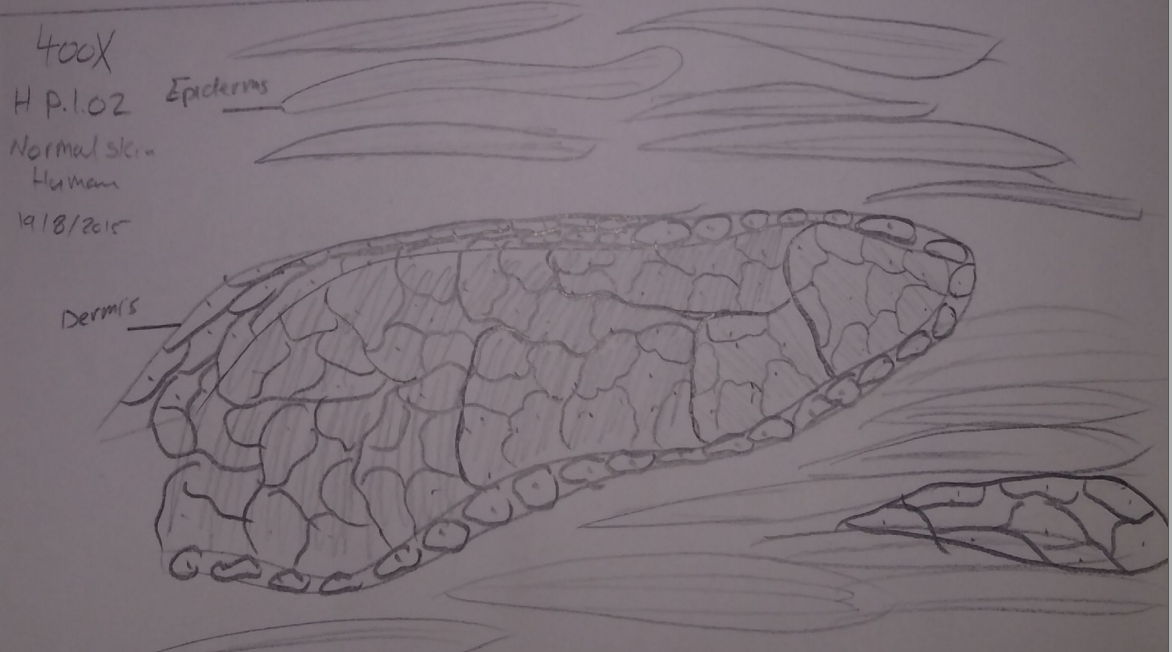
There are two types of human skin, i.e., the hairy and the non-hairy one. The latter is characterised by a thick epidermis, whereas the former one is represented by a thin on. Among the appendages, which human skin may have, the following ones are traditionally listed: hair, nails, sweat glands and sebaceous glands (Yong, Woodford & O’Dowd 2013).
Carcinoma
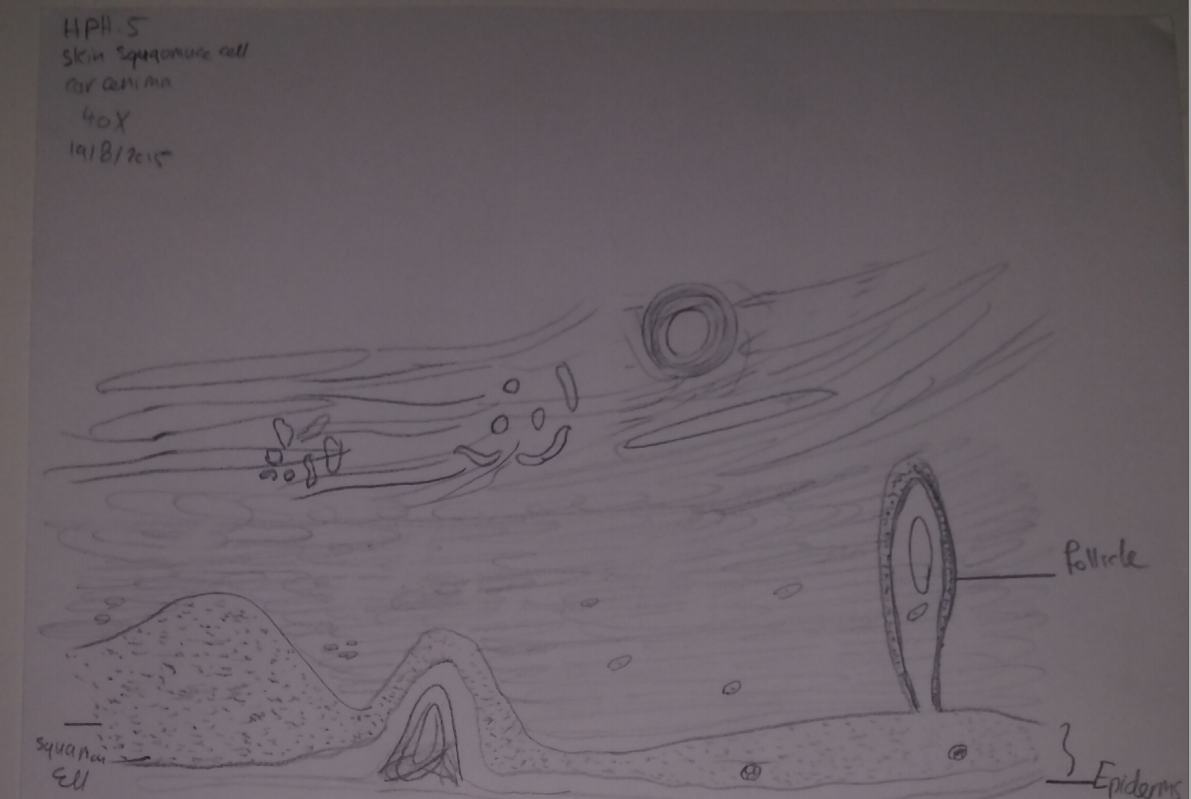
As the picture provided above shows, the carcinoma appears in the squamous cells of the skin. The type of carcinoma in question can be considered the second most common one in cancer patients (Alam, Bordeau & Yu 2013). Defined as the uncontrolled increase in abnormal cells among the skin squamous ones, the phenomenon in question affects the external layers of skin, i.e., the epidermis, for the most part (Alam et al. 2013).
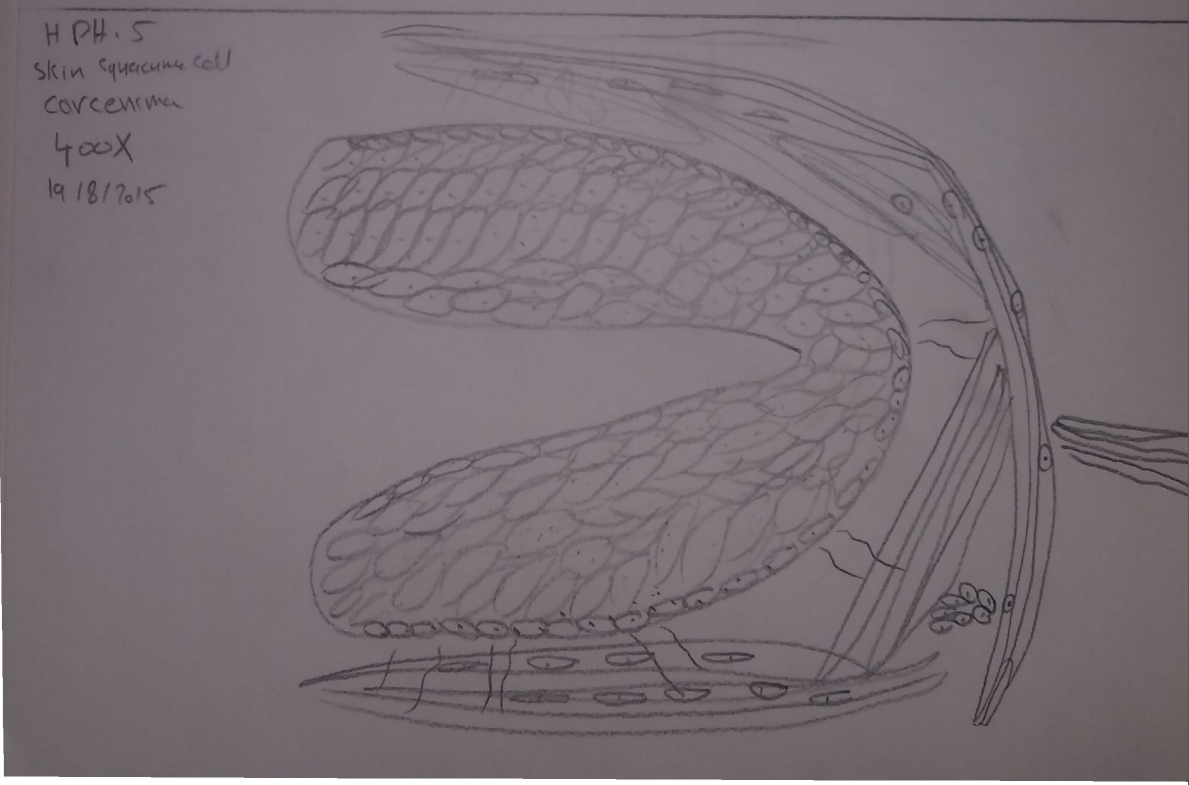
In addition, the basal cells of the skin have been affected by the disease. The specified type of melanoma is the most frequently occurring one. Unlike the squamous cell carcinoma, the disease in question occurs in the deepest layer of the epidermis. Though the basal cells carcinoma is not metastatic, it still has to be addressed correspondingly (Alam et al. 2013).
Disease Progress
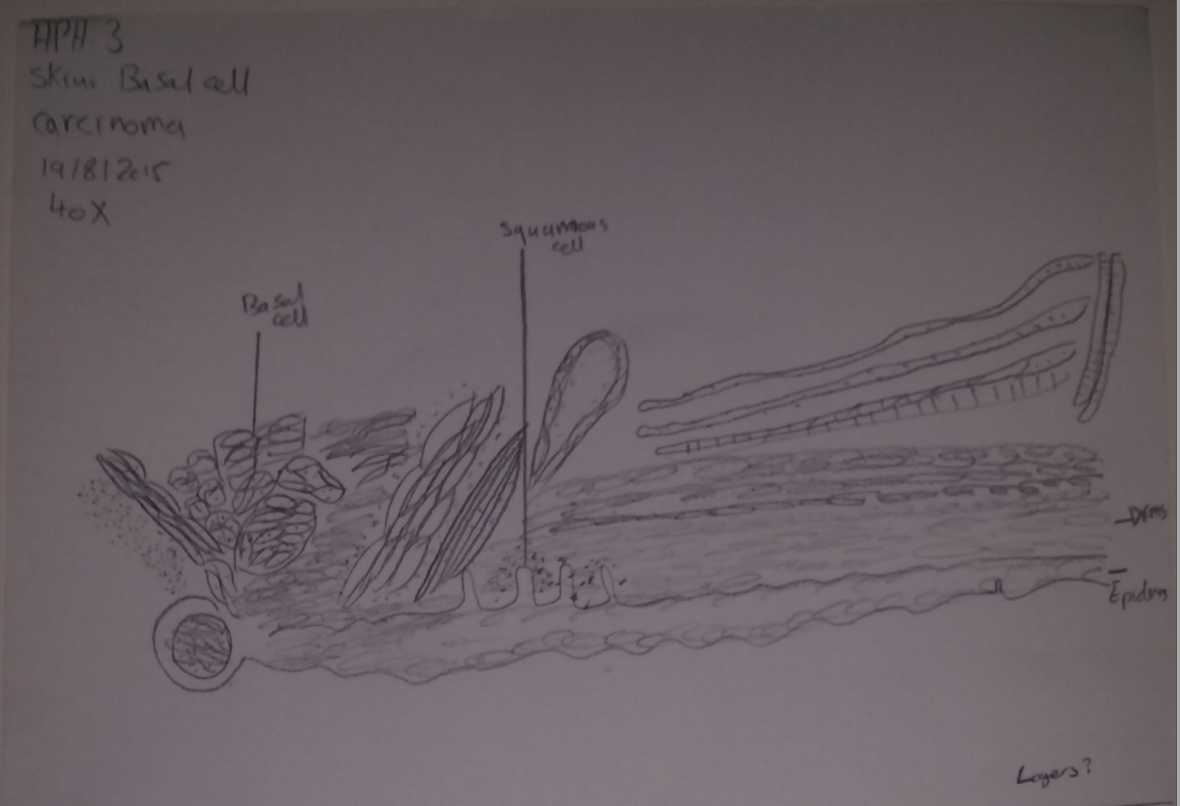
As it has been stressed above, BCC does not trigger metastases in the patient, in contrast to SCC (Alam, Bordeau & Yu 2013). The disease typically manifests itself as red sores, scars, etc. As a rule, the disease is caused by a consistent and unceasing exposure to the sun. The SCC, in its turn, also takes the form of red sores in most instances. However, unlike the BCC type of carcinoma, the specimen in question typically develops a crust on the surface of the carcinoma and often bleeds (Alam, Bordeau & Yu 2013).
Therefore, exposure to any form of radiation can be considered the primary risk factor when it comes to the development of carcinoma in patients. The condition in question needs to be treated accordingly; after the excision, the Mohs surgery needs to be carried out. Seeing that the surgery cannot possibly remove every single trace of carcinoma in the patient’s body in some cases, it may be required to undergo radiation therapy instead (Nouri 2012).
Malignant Melanoma
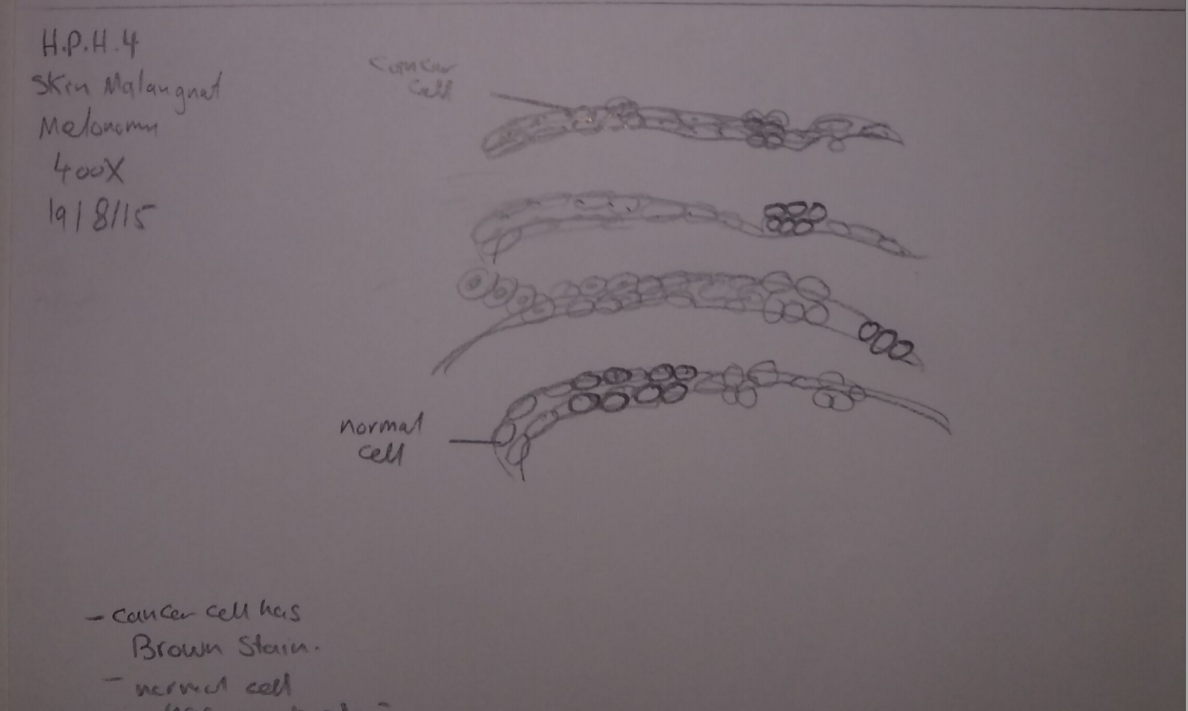
A malignant melanoma is a form of skin cancer, which is triggered by the melanocyte cells in the patient’s skin. The specified type of cancer is usually caused by long-term exposure to UVA and UVB rays. The specified type of skin cancer can be found in the basal layer of the epidermis. As the specimen under analysis shows, melanoma manifests itself as a rapid change in the skin colour in particular spots. Additionally, melanoma occurs as a spot of an asymmetrical shape. Finally, a melanoma has irregular borders, as the example under analysis shows (Barnhill 2012).
Malignant Melanoma in a Patient
Apart from a rapid change in the skin colour on a specific area, which has been discussed above, a malignant melanoma can be identified with the help of the so-called ABCDE principle (Asymmetry, Border irregularity, Color, Diameter, and Evolving). The latter is especially important in diagnosing the malignant melanoma – unlike other types of lumps, the given one grows consistently (Alam et al. 2013).

However, apart from the test in question, additional checks must be run to diagnose the patient correctly. Particularly, a biopsy must be mentioned among the most evident choices. As a rule, three types of a biopsy are identified; these are the punch, the excisional and the incisional biopsy types. The above-mentioned methods of a skin exam can be considered the most trustworthy in terms of results accuracy (Alam et al. 2013).
Basal Cell Carcinoma
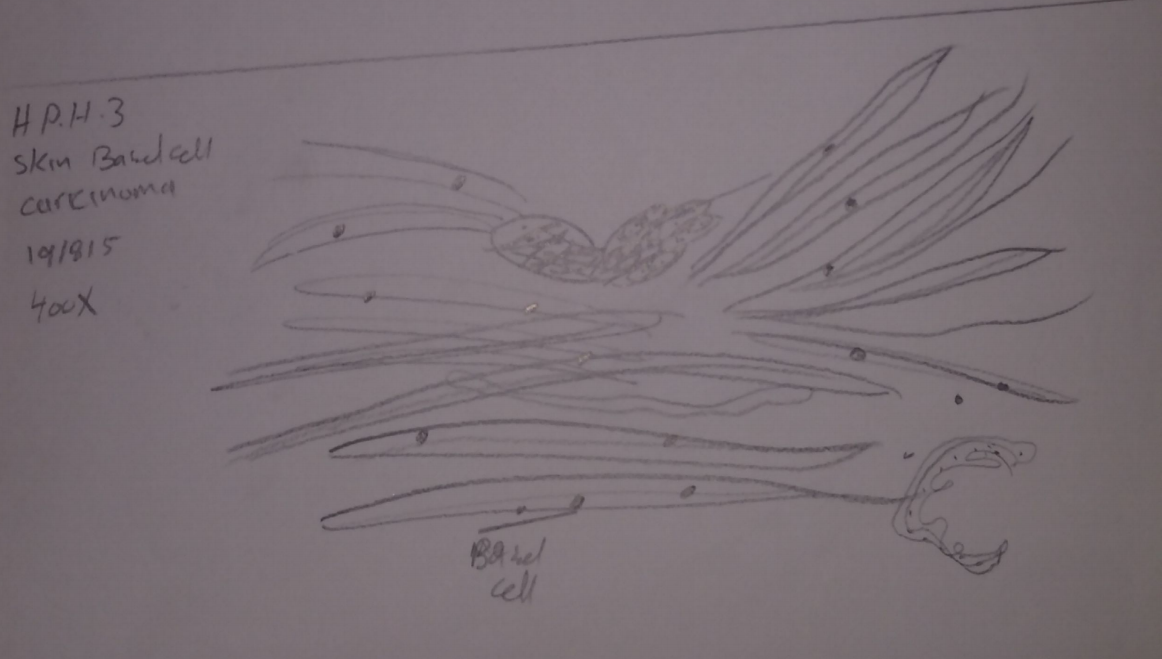
As the exhibit under analysis shows, basal cell carcinoma is located in the area, where squamous cells grow. The location under analysis can be considered rather typical for this type of carcinoma. The specimen under consideration also displays the typical behaviour of the carcinoma; to be more specific, the fact that the tumour rarely leaves the site of its original location should be brought up. Indeed, by definition, BCC practically never leaves the original site of the tumour development, which contributes to a faster and more efficient recovery of the patient. Therefore, the tissue sample in question can be deemed as a very basic representation of a typical basal cell carcinoma (Alam et al. 2013). The prognoses of the disease in question are usually positive, the patient having rather high chances of recovery as long as the corresponding treatment options are provided to them.
Morphology of a Breast
A woman’s breast can be defined as the gland that is located under the skin and can produce milk. A breast consists of the superficial fascia, the deep fascia and Pectoralis Major m. There is a potential space between the deep fascia and the breast; as a result, the latter can move. The breast is found in between the second and the sixth rib and is mostly composed of glandular tissue. As a rule, most breast lumps, including breast cancer, occur in the specified area. An auxiliary tail is the breast tissue found on the medial auxiliary wall (Vorherr 2012).
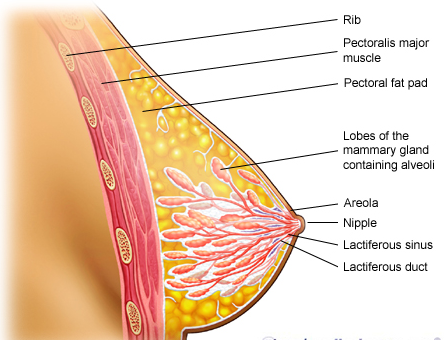
As the diagram above shows, the Pectoralis Major m. helps keep the breast in place, whereas the pectoral fat pad serves as the storage for the mammary glands. Lactiferous ducts help conduct milk to the lactiferous sinus, which disperses milk (Moini 2012).
Lobular and Connective Tissue: Ratio
Seeing that both lobular and connective tissue types are represented in a breast, it is essential to determine the ratio between the two so that changes to the breast tissue could be identified easily, and the corresponding measures should be undertaken before the possible lump can develop into a malignant tumour.
It should be noted, though, that the ratio in question often depends on the properties of a particular breast, such as its firmness, elasticity, etc. Therefore, the actual number that he ratio under analysis is expressed by may vary depending on the characteristics of a patient, such as age, environment, etc. Nevertheless, the ratio in question typically equals 1:1 in the women, who are not pregnant and do not have children (infants) (Moini 2012). As far as lactating women are concerned, the specified ratio may reach 1:2 (Bagheri, Bell & Khan 2011).
Pathology of Lobular Hyperplasia
The pathology of lobular hyperplasia can be defined as the emergence of a new and alien type of cells in the breast tissue. In the worst case scenario, the specified term signifies that a tumour has been developing in the patient’s breast. The phenomenon of lobular hyperplasia pathology also presupposes that the patient is predisposed to a carcinoma (Bagheri et al. 2011). Therefore, a lifelong observation of the patient with regular visits to the doctor and regular checks is strongly advised. As it has been stressed above, the standard ratio of lobular tissue to connective one ranges from 1:1 to 1:2. Therefore, everything that goes beyond the stated limit should be considered a reason for concern. The atypical tissue is quite easy to identify by considering the above-mentioned ratio; as soon as it is out of proportions, the patient needs to undergo a check.
Reasons for Lobular Hyperplasia
The exact reasons for the disease under analysis to develop are not yet known. It is assumed that lobular hyperplasia typically develops due to the alterations in the size of the breast or the effects of the exposure to mechanic forces (e.g., a severe blow to the breast) (Moini 2012). Therefore, it is advised that the patient should not expose themselves to an excessive amount of any kind of radiation, including the solar one. In addition, lobular hyperplasia may be caused by an abnormal BRCA1 or BRCA2 gene (Washington & Leaver 2015).
A lobular hyperplasia typically manifests itself in the emergence of abnormally large cells in place of the breast ducts and lobules in the patient. In order to diagnose the issue, the therapist will have to carry out a biopsy. Afterwards, the patient is suggested to undergo a surgery in case the analysis turns out to be positive (Washington & Leaver 2015). Despite the fact that the disease is treatable, coping with it presupposes undergoing a range of stressful procedures.
Lobular Hyperplasia and Possible Complications
Apart from being rather threatening on its own, lobular hyperplasia may trigger further complications in the patient’s health. To be more exact, the subject matter may lead to a range of other serious conditions. Particularly, the issue such as breast cancer deserves to be mentioned (Washington & Leaver 2015).
Indeed, even years after diagnosis and successful treatment of the problem, a range of women face the threat of developing breast cancer (Washington & Leaver 2015). According to a recent study, the two phenomena are related directly to each other: “Age-related atrophy of breast lobules (lobular involution) has been found to be inversely associated with risk of breast cancer” (Boyd, Martin, Yaffe & Minkin 2012). Therefore, it will be legitimate to suggest that a lobular hyperplasia may lead to the development of breast cancer.
Fibroadenoma
Fibroadenoma is a disease that presupposes the development of fibrous tissue in the breast; in other words, the subject matter is an umbrella term for all types of lumps that can be found in a woman’s breast (Moini 2012). As a rule, the lump is created from the breast gland tissue (Boyd et al. 2012). Due to the increase in the amount of lobular tissue, the ratio of the latter and the connective tissue is likely to grow.
Fibroadenoma: Symptoms
The symptoms of the disease are rather basic; the emergence of movable lumps under the skin of a woman’s breast traditionally signifies the development of a fibroadenoma. In addition to being mobile, these lumps share the properties such as firmness, rubbery sensation, and a complete absence of any pain (Boyd et al. 2012).
Fibroadenoma Treatment
The disease can be treated in several ways. The first and the most radical treatment concerns the removal of the tissue and, therefore, the breast with the help of lumpectomy, or excisional biopsy. Although the specified approach is traditionally considered the most efficient one in terms of possible recidivism, nonsurgical management is also used (Boyd et al. 2012).
Scirrhous Carcinoma: Description
Scirrhous carcinoma is typically defined as the malignant tumor that grows in fibrous tissue and develops at a comparatively slow pace, yet has drastic effects on the patient’s well-being (Kobayashi 2012).
Scirrhous Carcinoma: Symptoms
Scirrhous carcinoma can be identified by paying attention to the symptoms such as the emergence of painless, yet rapidly increasing lumps on one’s breast. The disease can be considered fairly common, as the key causes of the disease have not been identified yet (Kobayashi 2012). However, further researches may help identify primary causes and develop preventive measures to reduce the number of instances of scirrhous carcinoma development in female patients.
Scirrhous Carcinoma: Treatment
The basic treatment of the disease in question presupposes that surgery should be used as the means of removing the tumour. First, a biopsy is carried out to diagnose the disease and design an appropriate method of treatment for a particular patient. Afterwards, a surgery is performed with the following removal of the lump. Patients with scirrhous carcinoma have high chances for recovery, yet they will have to adopt a very rigid set of lifestyle rules after the surgery (Kobayashi 2012).
Reference List
Alam, M, Bordeau, J S & Yu, S S 2013, Merkel cell carcinoma, Springer Science & Business Media, Berlin.
Bagheri, S C, Bell. B & Khan, H A 2011, Current therapy in oral and maxillofacial surgery, Elsevier, New York City, New York.
Barnhill, R L 2012, Pathology of malignant melanoma, Springer Science & Business Media, Berlin.
Bennett, J M 2012, Controversies in the management of lymphomas: including Hodgkin’s disease, Springer Science & Business Media, Berlin.
Boyd, N, Martin, L J, Yaffe, M J & Minkin, S 2012, ‘Mammographic density and breast cancer risk: current understanding and future prospects’, Breast Cancer Research, vol. 13, no. 6, pp. 223–234.
Breast. n. d., Web.
Kobayashi, T 2012, Clinical ultrasound of the breast, Springer Science & Business Media, Berlin.
Moini, J 2012, Anatomy and physiology for health professionals, Jones & Bartlett Publishers, Burlington, Massachusetts.
Nouri, K 2012, Mohs micrographic surgery, Springer Science & Business Media, Berlin.
Vorherr, H 2012, The breast: morphology, physiology, and lactation, Elsevier, New York City, New York.
Washington, C M & Leaver, D T 2015, Principles and practice of radiation therapy, Elsevier Health Sciences, New York City, New York.
Yong, B, Woodford, P & O’Dowd, G 2013, Wheater’s functional histology: a text and colour atlas, Elsevier Health Sciences, Philadelphia Pennsylvania.